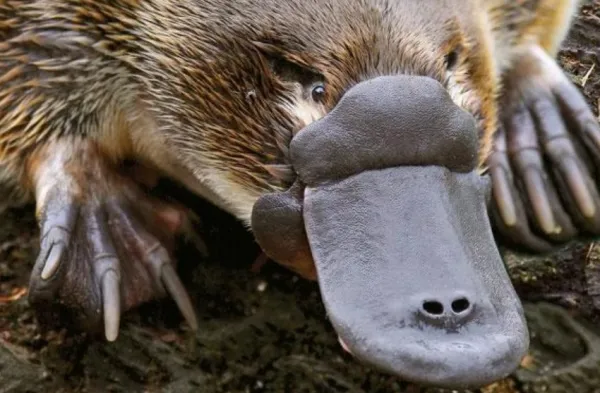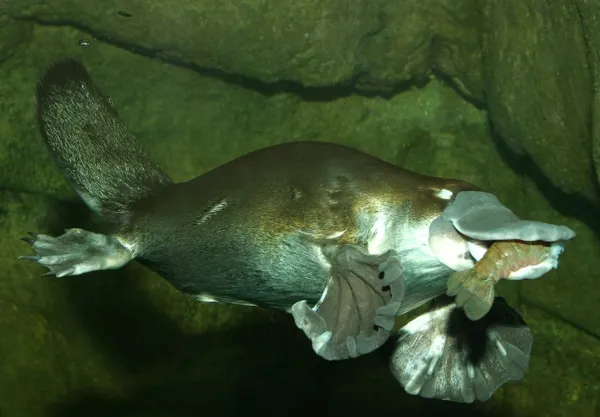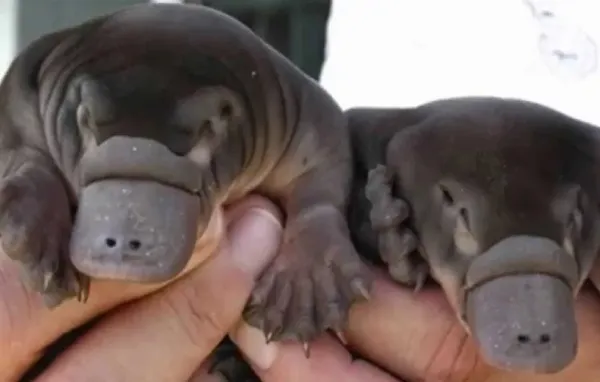The platypus (Ornithorhynchus anatinus) is often considered one of the strangest animals on Earth. Native to Australia and belonging to the monotreme order, it possesses a highly unusual anatomy: a duck-like bill, a beaver-like tail, and webbed feet resembling those of an otter or aquatic bird. One of the most fascinating traits of this mammal is that, despite having mammary glands and feeding its young with milk, it lays eggs—much like reptiles and birds.

Even more incredible, the male platypus is one of the few venomous mammals in the world. It has spurs on its hind legs that can deliver venom. Although not deadly to humans, the venom can cause intense pain and weakness. The platypus is an excellent swimmer and is primarily found in the freshwater rivers and streams of eastern Australia. As a carnivore, its diet mainly includes annelid worms, insects, shrimp, and small crabs.
Due to its unusual nature, many people wonder: Is the platypus endangered? In this article, we’ll explore the current status of the platypus, the threats it faces, and what we can do to protect it.
Let’s begin by addressing the main question. According to the International Union for Conservation of Nature (IUCN), the platypus is currently listed as Near Threatened. This means it is not officially endangered yet, but it is at risk if current trends continue. The classification suggests that although the species is not currently facing imminent extinction, it requires close monitoring and proactive conservation to avoid further decline.
When it comes to estimating the total number of platypuses in the wild, there is no precise figure. The IUCN estimates the global population to range between 30,000 and 300,000 individuals. Unfortunately, like many species worldwide, the platypus is not immune to environmental threats.
Climate change is a global environmental issue affecting virtually all species, including humans. Platypuses, as semi-aquatic mammals, are particularly vulnerable to frequent droughts and extreme weather caused by the increasing concentration of greenhouse gases in the atmosphere. Water shortages have a direct impact on their survival, affecting their habitat, food availability, and reproductive success.
We recommend learning more in our article: Endangered Animals Affected by Climate Change.
As semi-aquatic animals, platypuses depend on healthy freshwater ecosystems. Dams and reservoirs disrupt natural river flows and fragment their habitats. Additionally, urban expansion increases demand for freshwater and causes higher levels of water pollution. Agricultural runoff, chemical waste, and construction projects all contribute to the degradation of their living environment.
To understand the broader context, see: Environmental and Habitat Destruction: Causes and Consequences.
While it may seem harmless, a lack of sufficient data can pose a serious risk. Many researchers believe the platypus is exposed to more threats than currently recognized, and it may already qualify as Vulnerable or even Endangered if more accurate information were available.
Insufficient data also means conservation efforts may be inadequate or misdirected, potentially leading to a silent decline in the species.
Now that you know why the platypus is considered Near Threatened, here are a few meaningful ways individuals can help:

Since climate change is a major threat, lowering your personal carbon emissions can indirectly help the platypus. Simple actions like cycling instead of driving, reducing meat consumption, using energy-efficient appliances, and choosing renewable energy sources all contribute to a healthier planet.
Many household cleaners and agricultural chemicals end up in rivers, polluting the water that platypuses rely on. You can help by choosing biodegradable cleaning products and supporting organic farming, which minimizes pesticide and fertilizer runoff.
There are numerous wildlife organizations working to conserve the platypus. Many accept international donations and allow you to contribute from anywhere in the world. Some even provide opportunities to adopt or sponsor a platypus, supporting research and habitat protection projects.
The more people understand the threats facing the platypus, the more pressure there is on governments and institutions to take action. Educate yourself and others, share reliable articles, and advocate for stronger environmental policies.
To dive deeper, read: Why It's Important to Protect Endangered Species.
The platypus is not only an evolutionary marvel but also a vital part of Australia's ecosystem. Losing such a unique animal would be a tragedy—not just for biodiversity but for science and future generations. By taking small but meaningful actions, we can all help ensure the survival of this incredible species.

Recommended Reading:
[Endangered Animals Due to Climate Change]
[How Habitat Destruction Threatens Biodiversity]
[The Importance of Protecting Endangered Species]
Bibliography
Platypus (Ornithorhynchus anatinus) Fact Sheet. Red List of Threatened Species. International Union for Conservation of Nature (IUCN). Retrieved from: https://www.iucnredlist.org/species/40488/21964009
animal tags: Platypus
We created this article in conjunction with AI technology, then made sure it was fact-checked and edited by a Animals Top editor.